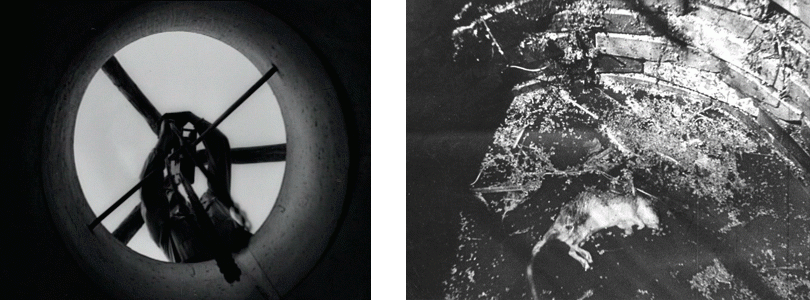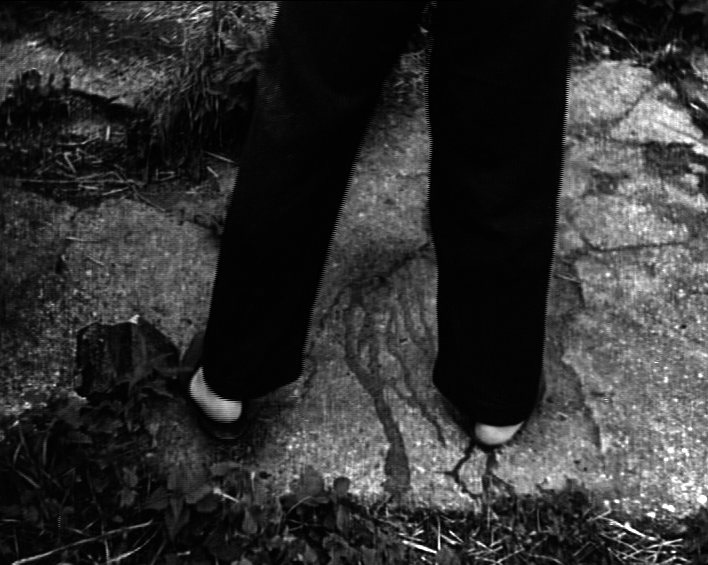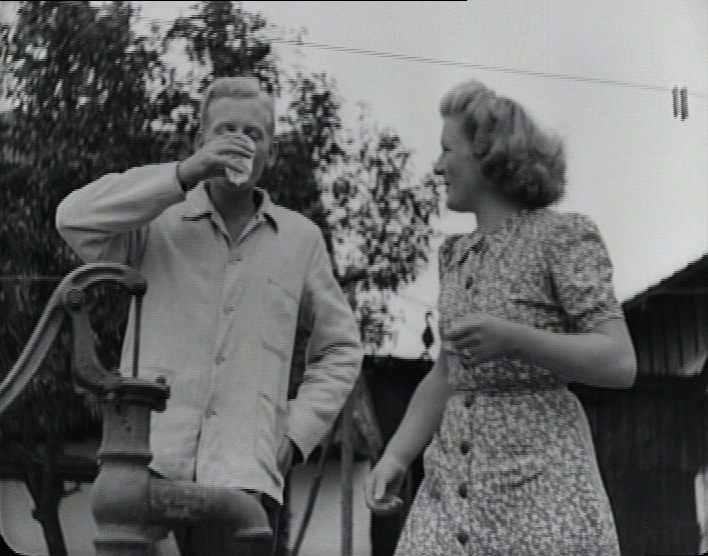
"… But when you are making propaganda, you have to tell the truth."[1]
So Carl Th. Dreyer told an interviewer in 1947. It’s an intriguing statement, and a somewhat surprising one. A requirement for truthfulness is not something we usually associate with propaganda; indeed the word today carries strong associations of deceitfulness and manipulation, and tends to be associated with the activities of figures like the Nazi propaganda minister Goebbels. The word did not always have quite this pejorative sense; after all, Goebbels chose the title of Minister of Propaganda for himself. Still, right from its Jesuitical origins, the word propaganda carried associations of presenting things with a certain slant; putting the best face on things.
The purpose of the film is to frighten
The year before the interview, Dreyer had made a short film for the government called Vandet paa Landet (“The Water in the Country”) about the unhealthy condition of the well-water in rural areas, but the authorities decided to suppress it, preventing it from being shown. The film remained shelved and unavailable for public screening until recently, making it the least-known and least-seen of all Dreyer’s pictures. Postproduction on the film was never completed, and the soundtrack remained separate from the images until 2007.
In the 1947 interview, Dreyer protested against the shelving of the film: “Everything in the finished film was written in the script approved by the National Health Board. Some of the officials later thought that the film was a bit too realistic. But when you are making propaganda, you have to tell the truth. The purpose of the film is to frighten!”[2]
In the following, I won’t be trying to establish whether Dreyer’s film accurately reflected prevailing sanitary conditions. Rather, I’ll be looking, in a manner of speaking, at the relation between the telling and the frightening.
Cognitivists like Torben Grodal have argued that when we engage emotionally with a film, we rely on the same mental machinery that we use in our engagement with the real world, so that we respond to artworks with true emotions; a film can really frighten us.
Other scholars, however, stress the categorical difference between discourse and the real world, relying instead on a rhetorical approach; a film is something told to us.
While I shall argue that a rhetorical perspective is inescapable when dealing with propaganda films, works where persuasion and design are obviously involved, I’ll try to show how a rhetorical approach can be usefully integrated with a cognitive-evolutionary one.
The making of Vandet paa Landet
Vandet paa Landet was commissioned by the Danish National Board of Health after a survey of hygienic conditions in certain rural areas in 1944 had given rise to grave concerns about the quality of local well water.[3] Improvement of the conditions was given a high priority, and the National Board of Heath had asked the Ministerial Film Committee to commission a film supporting these efforts. This committee had been established during the German occupation, in 1941, to oversee the production of government-sponsored short films. These proved very popular with audiences, particularly since they replaced the widely resented German propaganda shorts, and nearly fifty were made during the war. After the liberation in May 1945, the Ministerial Film Committee remained in place, and in the fall they decided to finance the making of the film promoting cleaner well water. Carl Th. Dreyer was given the job.
Dreyer finished the screenplay in late September 1945 and shot the film in October and November, with some additional shooting the following spring. Dreyer did not supervise the recording of the soundtrack in June 1946, but turned that over to Mogens Skot-Hansen, a civil servant who also wrote film scripts, directed shorts, and was production manager for the Ministerial Film Committee. Dreyer claiming that since Skot-Hansen knew much more about sound post-production than he did, he would just be a passive onlooker anyway.
The soundtrack features three characters. Two of them are experts – a district medical officer and a water engineer. They patiently but firmly instruct a third person on the importance of well water hygiene. The third voice is an inquisitive but somewhat jokey fellow whose intonation marks him as a man from the big city; Dreyer’s script refers to him as “The Man from Copenhagen.”
DFI: Vandet paa Landet (film clip).
The final result
When the unsanitary water is used to wash milk churns, typhoid germs may get into the milk and cause an epidemic. The film therefore urges farmers to replace their old wells with new, seepage-proof cement-lined ones.
But while the film contains inspiring images of such a well being built, what is likely to remain with spectators is the idea of typhoid-laced milk and images of well-water filled with disgusting things.

When the completed film was shown to the Ministerial Film Committee, the reaction was outrage. According to Skot-Hansen, the committee chairman exclaimed that the film would undo a century of efforts to promote the quality of Danish agriculture. “And with Dreyer’s name on it, it will be shown everywhere!”[4] Over Skot-Hansen’s violent protests, the decision was made to shelve the film. Danish agricultural exports have a crucial significance for the Danish economy, and the responsible authorities felt they had every reason to stop a film which would associate Danish agriculture with images likely to make spectators react with fear and disgust.
Disgust - a basic human emotion
Emotion researchers generally regard disgust as one of the basic human emotions. Emotions, on a Darwinian view, help us respond to the environment in ways that benefit our survival. Cognitive film theory argues that what we see in films activate the same mental mechanisms in us that the same sights in real life would: Torben Grodal writes that when we engage with films, we use the “mental architecture … developed to allow for a sophisticated navigation of our bodies in space so that we can obtain food, water, and mates, whilst avoiding predators and enemies”,[5] to which I might perhaps add disgusting things.
When watching films where people engage in such struggle-for-existence-type activities, we simulate the emotions that ready people for such actions, and we simulate them from within, in the first person; we have a vicarious experience. An emotion like disgust can only be fully understood from within, muscles tensing, the stomach tightening, bile rising in the throat. The vicarious experience activates the same mental processes as a real experience. The difference between “our reactions to actual and photographically represented disgusting objects is one of degree and not of kind,” as Carl Plantinga writes in his article Disgusted at the Movies.[6] Accordingly, Grodal goes on to claim that “media representations are better described as various realizations of basic real-life experiences.”[7]
Criticizing the cognitive approach
Some narratologists, however, are unconvinced. Meir Sternberg, for instance, regards the "difference in (im)mediacy between life and text life" as fundamental. In several book-length articles, he has criticized the cognitivist approach to narrative. What Sternberg calls the "cognitivist twinning of first-order with discourse-mediated reality"[8] – and Grodal’s model of aesthetic experience is certainly an example of that – is, according to Sternberg, a "category mistake."[9]
Sternberg stresses the “discontinuity between the telling and the told”, the way “the represented action itself entails a process of communication for its very deployment in text and mind.”[10] With the emphasis on this process of communication, it is not surprising that the narratologist James Phelan, in his survey of the field, numbers Sternberg among those who take a rhetorical approach to narrative – as he does himself.
The rhetorical approach
Phelan defines the rhetorical approach as one that regards “Narrative as a purposive act of communication about characters and events: somebody telling somebody else on some occasion and for some purpose(s) that something happened.”[11] In this view, crucial importance is attached to our judgment of both the characters and the tellers and their purposes. The cognitive approach, on the other hand, is one that asks: “What are the mental tools, processes, and activities that make possible our ability to construct and understand narrative?”[12] The focus is on the mental processes of engagement, as one might also call it to better include the direct, immersive qualities Grodal emphasizes.
There is nothing, however, in Phelan’s description of the two approaches that says that they must necessarily be at loggerheads in the manner that Sternberg suggests. That is good, because it is difficult not to think of propaganda in rhetorical, communicative terms. There are many definitions of “propaganda”, and they’ve been explored in some detail by the British historian David Welch in Propaganda and Mass Persuasion: A Historical Encyclopedia from 2003. Having reflected carefully on the various senses of the word, he offers his own definition of propaganda. It is “the deliberate attempt to influence the opinions of an audience through the transmission of ideas and values for a specific persuasive purpose, consciously designed to serve the interest of the propagandist and their political masters, either directly or indirectly.”[13]
Note the intentional emphases: “a deliberate attempt”; “consciously designed”.
The use of an audience character
Dreyer’s film Vandet paa Landet has numerous features that not only show deliberate design but requires spectators to recognize that they have been designed if they are to work properly. One example is the use of what we may perhaps call an audience character: a character within the film who is the ostensible addressee of the film’s message. In Dreyer’s film, it’s the whistling city-dweller. Another amusing example can be found in Richard Massingham’s wonderful public health information film from 1945, Coughs and Sneezes.
YouTube: BFI Films
Having the authorities lecture you on matters of personal hygiene is just the sort of thing that leads to complaints about the “nanny state.” But the bumbling, slightly dim-witted figure (played by Massingham himself) shields the audience from the hectoring of the narrator, enabling us to watch them film with amusement and enjoyment even while remaining aware that the message is really directed at us.
Both Vandet paa Landet and Coughs and Sneezes rely on an implied contrast with the insistent direct address used in many propaganda films. Not only do we get to feel superior to the audience character, we are also allowed by the films as a whole to assume a slight ironic distance to the voices of authority, rather than expecting us to take the words of the voice-of-God narrator as gospel, so to say.
In the context of World War Two and the immediate post-war period, the contrast had political implications as well, the hectoring direct address being associated with Nazi propaganda. Its unsmiling and browbeating style was perceived as characteristically Teutonic, and humor, in contrast, was taken to be characteristically English – or Danish, as the case might be. A nice example of how humor could be deployed in this nationalistic fashion can be found in a Danish government short from 1944, directed by Ole Palsbo: Kartofler (“Potatoes”). Its ending, with billowing cornfields and anthem-like choir singing “Potatoes here / potatoes there / potatoes e-ve-ry-wherrre”), pokes fun at the kind of beautifying landscape photography and stirring music characteristically used in nationalistic propaganda, but also still allows a Danish audience to take pride in the beauty of their landscape, the ingenuity of their potato use, and the wit of their filmmakers.
None of these films, I think, can really be understood, appreciated or enjoyed without attention to rhetorical features like audience characters, humor, irony, and nationalism. The question then becomes how we may connect this rhetorical understanding with the cognitivists’ descriptions of the mental structures we use to comprehend this and other films?
Virtue rewarded and vice punished
A powerful and suggestive answer has been provided by the English professor William Flesch in his book Comeuppance: Costly Signaling, Altruistic Punishment, and Other Biological Components of Fiction. Flesch seeks to understand why we care about fictional characters, asking “what the mind must have evolved to do to be able and eager to tell and hear stories?”[14] These questions obviously anchor Flesch’s work in the cognitive approach.
He argues that our concern with fictional characters builds on the way we vigilantly track and monitor the activities of other human beings, particularly the way they behave towards others. We monitor others because we are concerned that those who treat others well (cooperators, in the game-theoretical terminology used by Flesch) should be rewarded. We are even more concerned that those who treat others badly (cheaters or defectors, in game-theoretical terms) should be punished. In Flesch’s words: “We evolved so that we punish cheaters, take pleasure in punishing cheaters, and take pleasure in watching others punish cheaters.”[15] Flesch describes this pleasure as “a pleasing sense of outrage at defection and a concomitant sympathy for the victims of defection.”[16]


This encourages us to engage in or at least strongly approve of those who engage in altruistic punishment: expending energy on punishing cheaters without any particular benefit for the punisher. If cheaters went unpunished, human cooperation would not have been sustainable in evolutionary terms: the cheaters would outcompete the cooperators. And not only must cheaters be punished, but also those who fail to punish them, because they are free-loading off those who expend their energy on punishing the cheaters. Therefore, we need to track not only the actions of others, but the way others respond to those actions in turn.
Storytelling can function as a kind of punishment too, exposing the bad behavior of cheaters and holding them up to shame. In Vandet paa Landet, the audience character is a city dweller, a potential costumer and vacation guest, and exposing the dirty secrets of the country water to him may have severe repercussions. Storytellers, in this case Dreyer and the National Board of Health, may thus assume the role of altruistic punishers, signaling to the farmers that they should get their act cleaned up and at the same time signaling to the rest of the audience that the authorities are vigilant and unbending in their commitment to the greater good.
Flesch argues that our pleasure in seeing virtue rewarded and vice punished remains even if the reality status of the figures involved is fictive. This carry-over into the realm of the fictive is all the more easily achieved because reward and punishment are always responses to something non-actual, something not here and now. They are responses in the present to actions in the past. Flesh writes: “What we wish to track is past behavior, including past tracking of past behavior, in order to respond in the present to that behavior. Fiction recruits this central capacity in human social cognition for taking pleasure in responding to the nonfactual.”[17] While Flesch’s main concern is with works of fiction, it is obvious that we can become engaged in the same way by real-world behavior and take equal pleasure in seeing real-world cheaters exposed and punished.

The spectators' judgments
Flesch is more focused on the social aspects of human nature than Grodal, who emphasizes the struggle for existence, but Flesch’s theory strongly supports the fundamental notion that “media representations are various realizations of basic real life experiences.” At the same time, a strong connection with the rhetorical perspective is created by the way Flesch highlights mental processes that involve judgment: the judgment of characters and their motives, and beyond that, the judgment of storytellers and their motives.
Still, primary, direct emotions like the disgust provoked by the unsanitary well will color everything else. One can well understand that agricultural interests were only too happy to see Vandet paa Landet shelved.

However hopeful the conclusion, showing that the problem is being dealt with, we feel in our gut that the propaganda has told the truth, and that the well-water is infested with filthy germs. Dreyer saw his task as “frightening the audience,” and he succeeded all too well. All that we can do is tell the story, celebrate Dreyer’s craftsmanship, and thus perhaps give his censors a belated comeuppance.
This paper is based on a presentation given at the 6th Conference of SCSMI (Society for the Cognitive Study of the Moving Image), Madison, Wisconsin, 14 June 2008.
Suggested citation: Tybjerg, Casper (2013): Pissing into the Well: Dreyer, Film Propaganda and Cognitive Theory, Kosmorama #249 (http://www.kosmorama.org/ServiceMenu/05-English/Articles/Pissing-into-the-Well.aspx)
Notes
[1] "Propagandafilmens Formaal er at skræmme Publikum," Social-Demokraten, 15 May 1947. [Back]
[2] "Propagandafilmens Formaal er at skræmme Publikum." [Back]
[3] This account of the production of Vandet paa Landet is based on Lars Bo Kimergård, "Carl Th. Dreyer's kortfilmengagement i perioden 1942-52" (University of Copenhagen, 1992), 17-26; Lars Bo Kimergård, "Kortfilm som redningsplanke," Sekvens 1993(1993): 99-101. [Back]
[4] Quoted after Maurice Drouzy, interview with Mogens Skot-Hansen, 1 June 1978, in Maurice Drouzy, ed. Kildemateriale til en biografi om Carl Th. Dreyer (Copenhagen: C. A. Reitzel, 1982). [Back]
[5] Torben Grodal, "The PECMA Flow: A General Model of Visual Aesthetics," Film Studies, no. 8 (2006): 6. [Back]
[6] Carl Plantinga, "Disgusted at the Movies," Film Studies, no. 8 (2006): 86. [Back]
[7] Torben Grodal, Embodied Visions: Evolution, Emotion, Culture, and Film (Oxford: Oxford University Press, 2009), 159. [Back]
[8] Meir Sternberg, "Universals of Narrative and Their Cognitivist Fortunes (I)," Poetics Today 24, no. 2 (2003): 319. [Back]
[9] Sternberg, "Universals of Narrative and Their Cognitivist Fortunes (I)," 320. [Back]
[10] Sternberg, "Universals of Narrative and Their Cognitivist Fortunes (I)," 347. [Back]
[11] James Phelan, "Narrative Theory, 1966-2005: A Narrative," in The Nature of Narrative, ed. Robert Scholes, James Phelan, and Robert Kellogg (Oxford: Oxford University Press, 2006), 297. [Back]
[12] Phelan, "Narrative Theory, 1966-2005: A Narrative," 290. [Back]
[13] David Welch, "Propaganda, Definitions of," in Propaganda and Mass Persuasion: A Historical Encyclopedia, 1500 to the Present, ed. Nicholas J. Cull, David Culbert, and David Welch (Santa Barbara, CA: ABC Clio, 2003), 322; David Welch, "Powers of Persuasion," History Today 49, no. 8 (1999): 26. [Back]
[14] William Flesch, Comeuppance: Costly Signaling, Altruistic Punishment, and Other Biological Components of Fiction (Cambridge, Mass.: Harvard University Press, 2007), 4. [Back]
[15] "William Flesch: Murder Most Foul," http://my.brandeis.edu/profiles/one-profile?profile_id=1018. [Back]
[16] Flesch, Comeuppance, 50. [Back]
[17] Flesch, Comeuppance, 51. [Back]
CASPER TYBJERG / ASSOCIATE PROFESSOR
DEPARTMENT OF MEDIA, COGNITION AND COMMUNICATION
UNIVERSITY OF COPENHAGEN
